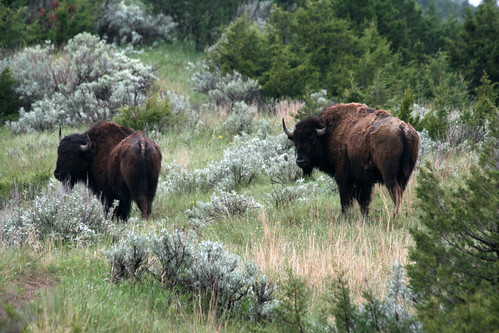Surprise! Bison calf born this month instead of in spring
Bison #Bison

It’s a girl! Probably.
The surprise arrival of a baby bison this month increased the size of the herd at Minneopa State Park to 45 animals.
Park Manager Ashley Steevens said most bison give birth in April and early May. One cow didn’t give birth this spring, then surprised everyone by giving birth to a calf on Oct. 2.
“I guess that’s when she was ready,” Steevens said. Though no up-close examination of the calf had occurred as of early this week, she said it is believed the calf is a girl.
The spring-born calves now weigh 325 to 400 pounds. The little one weighs between 40 and 50 pounds. Still, Steevens doesn’t anticipate problems for either the calf or the mother with the coming winter.
“They grow really fast.”
She also said early April weather is very similar to the weather this calf was born into. She expects the calf will have plenty of time to grow a winter coat. She also expects the mother to do well raising a calf through the winter months.
The mother is a healthy 12-year-old cow, according to Steevens. While that’s old for a dairy cow to give birth, bison reproduce into their 20s.
Other cows have nursed calves into the winter without problems, though some do wean their calves before winter comes. Because the park provides supplemental feed and a steady water source through the winter, she expects both mother and baby to do fine.
The newest addition to the Minneopa Park bison herd rests near a prairie boulder. Calves are usually born in the spring, but this baby arrived in October.
Courtesy Minneopa State Park
“We do manage them as wild as possible, but we also have a responsibility to their welfare.”
The veterinarian on record is aware of the birth, and should any problems occur, she said, any recommendations made will be followed.
Before winter sets in, a herd management day will occur. Bison will be weighed, vaccinated as needed, and an assessment of the prairie’s ability to support the animals will be made.
Originally, Minneopa Park was expected to be able to sustain 30 to 35 animals in the winter. Following three years of drought, that number may change. A decrease in the forage available under the snow on the prairie could impact that number.
As only one breeding bull is kept at the park, young males will be separated and re-homed, Steevens said. Also, Dakota County, which established a bison herd last year, will likely be in the market for a cow-calf pair.
Managing the prairie to support bison is has been impacted by the drought. In nature, prairies often burn, which renews growth. At Minneopa, not only do wind conditions have to be so that no nuisance smoke impacts neighbors or highways, but the dryness is a factor. Steevens said ideally, a small area can be burned even with the drought. When sprouts come up, the bison graze it and that renews the prairie. In past burns, she said, the bison have not acted as if bothered by the fire.
The park’s Bison Drive is now open 9 a.m.-6 p.m. every day except Wednesdays, when the road is closed for maintenance.
Park staff will keep tabs on the cow-calf duo, Steevens said, even though no problems are anticipated.
“Nature always finds a way. Nature takes care of itself.”